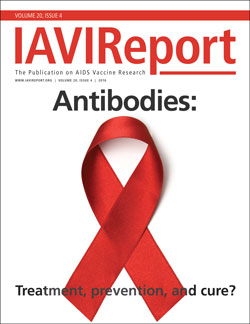IAVI REPORT – VOL. 20, NO. 4, 2016
 As the mother of a four-year old, I have plenty of occasions to talk about germs and viruses. Let’s be honest, I enjoy it. Add to that the number of times my daughter hears me talking about my work and it isn’t too difficult to understand why she’s been using the word antibody since she was two.
As the mother of a four-year old, I have plenty of occasions to talk about germs and viruses. Let’s be honest, I enjoy it. Add to that the number of times my daughter hears me talking about my work and it isn’t too difficult to understand why she’s been using the word antibody since she was two.
We’ve reported extensively on antibodies over the past few years as they have come to revolutionize efforts to prevent or treat HIV infection. And progress on this front continues. In this issue we report on the major findings presented at the HIV Research for Prevention (HIVR4P) conference held in October. At this meeting, as in many of recent memory, antibodies were a prominent theme. From the trials testing the ability of directly administered broadly neutralizing antibodies to prevent HIV infection to the latest efforts to engineer a series of vaccine immunogens that could induce these powerful proteins, antibodies are fueling scientific developments in many areas. Now the search for a functional cure can be added to the list. Just prior to the opening of HIVR4P, researchers from Emory University and the US National Institute of Allergy and Infectious Diseases, including esteemed head Anthony Fauci, reported that a small group of monkeys were put in sustained remission for a period of almost two years following receipt of an antibody and standard antiretroviral therapy. This result, though not yet fully understood, raises hopes that a similar response might be seen in humans with an already licensed antibody. Trials are now underway.
Progress in preventing the spread of HIV or in alleviating the burden of daily HIV therapy can’t come soon enough. Emilio Emini, director of the HIV program at the Bill & Melinda Gates Foundation, warns that the AIDS response is at a particular crucial juncture—particularly in sub-Saharan Africa where there is a large population of young people about to enter the age range when their susceptibility to contracting HIV is the highest. Emini and I spoke recently about this situation and how it provides the lens through which the Gates Foundation, the world’s largest charitable foundation, views all of its funding decisions.
It is within these vulnerable populations that the Centre for the AIDS Programme of Research in South Africa (CAPRISA) is striving to halt the epidemic through a variety of options. In this issue we also profile their impressive commitment to turning the tide against HIV and tuberculosis.
Taken together, the articles in this issue showcase the steadfast commitment of some of the field’s leading funders, scientists, and community research centers to seeing an eventual end of AIDS. We hope it fills you with hope and a renewed sense of optimism too. Happy holidays and best wishes for the new year.
—Kristen Jill Kresge


